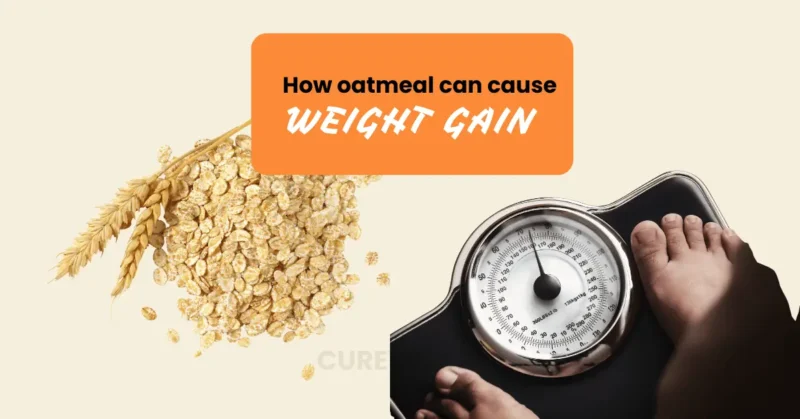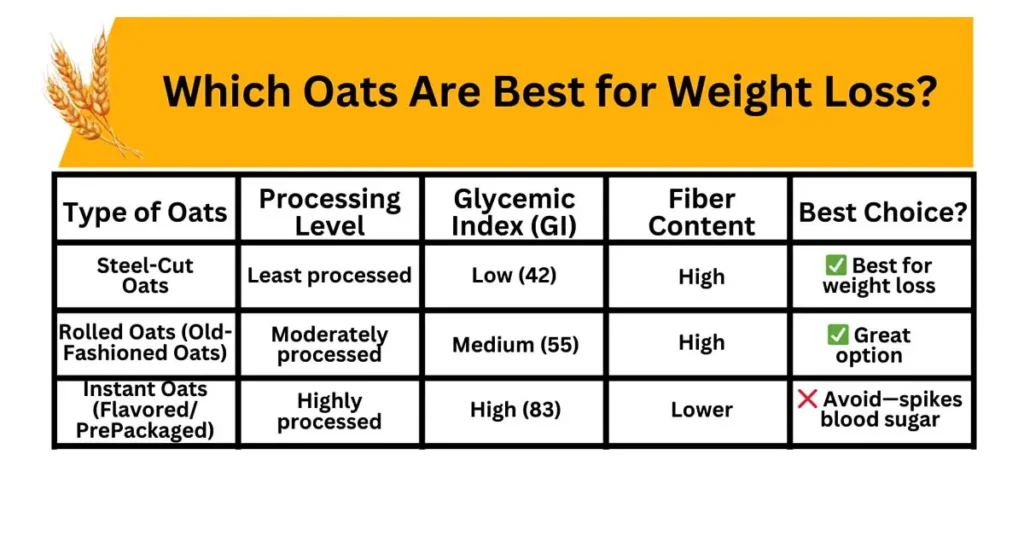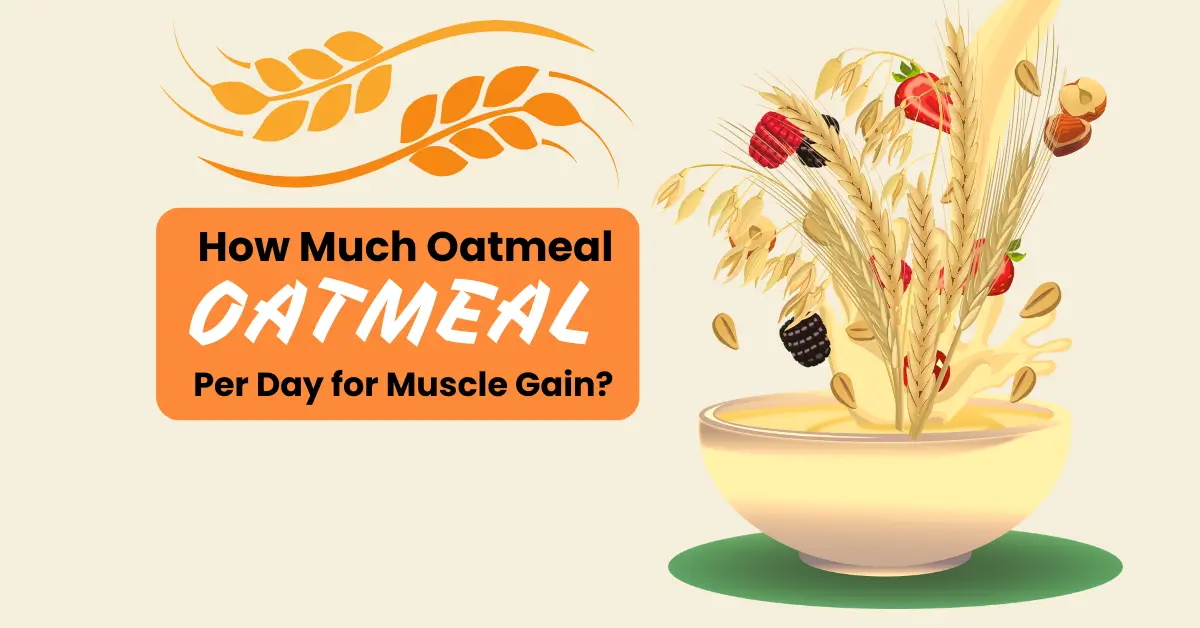Is oatmeal helping or hurting your weight loss goals? Discover the surprising truth behind the oatmeal paradox and how to make the right breakfast choice.
Thank you for reading this post, don't forget to subscribe!- Find out The Oatmeal Paradox
- Discover how oatmeal can help or hinder weight loss based on preparation methods.
- Learn about its nutritional profile and best practices to maximize benefits while avoiding hidden calorie traps.
- Not all oatmeal is created equal! Discover how portion sizes, high-calorie toppings, and flavored varieties can transform this healthy meal into a weight-gaining culprit—and learn how to enjoy it healthily.
How Does Oatmeal Really Function?
Oatmeal has earned a well-deserved reputation as a powerhouse breakfast option. It is often linked to heart health, sustained energy, and digestive well-being.
Rich in fiber and essential nutrients, it has been a go-to choice for health-conscious individuals.
However, many don’t realize that oatmeal’s benefits—or drawbacks—are primarily determined by how it’s prepared and consumed.

When eaten in its purest form, oatmeal provides a balanced mix of carbohydrates, protein, and fiber, contributing to satiety and stable blood sugar levels. Excessive toppings, added sugars, or large portions can turn this healthy dish into a calorie-rich meal, leading to unwanted weight gain.
Nutritional Blueprint: Examining the Power of Plain Oats
Understanding the nutritional composition of oatmeal is crucial for making informed dietary choices. A standard serving of half a cup of dry rolled oats, cooked in water, offers:
- Calories: 165
- Protein: 6 grams (Supports muscle maintenance and satiety)
- Fat: 3.5 grams (Mostly healthy unsaturated fats)
- Carbohydrates: 28 grams (Provides long-lasting energy)
- Fiber: 4 grams (Promotes digestion and fullness)
- Sugar: 0 grams (Naturally sugar-free, preventing blood sugar spikes)
This nutrient-dense profile highlights oatmeal as an excellent breakfast option. However, how it is prepared—whether laden with added sugars or combined with nutrient-dense toppings—can make all the difference in its impact on health and weight.
Oatmeal’s Role in Satiety and Energy Balance
One of the most significant advantages of oatmeal is its high fiber content, particularly beta-glucan, a soluble fiber known for:
- Slowing down digestion, leading to prolonged satiety
- Reducing cholesterol levels, improving heart health
- Stabilizing blood sugar, preventing energy crashes
Yet, how oatmeal is served can determine whether it sustains you or contributes to hunger spikes. A plain bowl of oatmeal delivers complex carbohydrates, which are digested slowly, ensuring a steady energy release.
However, when combined with excessive sweeteners and processed toppings, it can quickly lead to blood sugar fluctuations, increased cravings, and unintentional overeating.
Maximizing the Benefits of Oatmeal for Weight Management
To make oatmeal a powerful tool for health and weight loss, consider:
- Choosing Whole, Unprocessed Oats: Steel-cut or rolled oats retain more nutrients and have a lower glycemic impact than instant varieties.
- Watching Portion Sizes: A single serving (½ cup dry) is sufficient for sustained energy. Even eating too many nutritious foods can result in consuming too many calories.
- Adding Nutrient-Dense Toppings: Fresh berries, chia seeds, flaxseeds, and unsweetened almond milk enhance nutrition without unnecessary sugars.
- Avoiding Sugar Overload: Skip artificial sweeteners and flavored oatmeals, opting for natural flavor enhancers like cinnamon or vanilla.
How oatmeal can cause weight gain: Hidden Pitfalls

Oatmeal is often considered a superfood, but unintentional mistakes in preparation can sabotage its benefits.
Oatmeal is a heart-healthy, fiber-rich meal, but poor choices like oversized portions, sugary toppings, and instant varieties can make it a high-calorie indulgence.
Below, we examine the common mistakes that could be preventing oatmeal from supporting your weight management goals.
1. Excessive Portion Sizes: More Isn’t Always Better
Oatmeal is filling, but overeating at once can lead to excessive calorie consumption. A standard serving of ½ cup of dry oats expands significantly when cooked, making it a satisfying portion.
However, many people unknowingly double or triple this amount, thinking that a bigger bowl means a healthier meal.
Impact on Calories:
- ½ cup dry oats: ~165 calories
- 1 cup dry oats: ~330 calories
- 1½ cups dry oats: ~495 calories
Solution: Stick to the recommended serving size and bulk up your bowl with low-calorie, fiber-rich additions like chia seeds, flaxseeds, or fresh fruits instead of increasing the oats.
2. High-Calorie Additives: Hidden Sugar Bombs
Toppings can transform a bland bowl of oatmeal into a deliciously indulgent meal, but many commonly used add-ons are surprisingly high in sugar and fats.
Common High-Calorie Toppings to Watch Out For:
- Brown Sugar (1 tbsp): +52 calories
- Honey (1 tbsp): +64 calories
- Maple Syrup (1 tbsp): +52 calories
- Dried Fruits (¼ cup raisins): +108 calories
- Nuts (¼ cup almonds): +207 calories
Why This Matters: While natural sweeteners and nuts offer health benefits, they add up quickly in calories. A single tablespoon of honey adds more sugar than necessary, spiking blood sugar and leading to cravings later in the day.
Solution: Choose fresh fruit (like berries or banana slices) for natural sweetness and limit nut portions to a small handful to balance healthy fats without excessive calories.
3. Flavored and Instant Oatmeal: A Sugar Trap
Pre-packaged oatmeal may seem convenient, but many flavored and instant varieties contain added sugars, preservatives, and artificial flavorings.
What’s Inside Flavored Oatmeal?
- Added sugars (sometimes 10–15 g per packet)
- Artificial flavors and preservatives
- Reduced fiber due to processing
Example: A pack of flavored instant oatmeal can have as many as 180–200 calories and 12–15g of sugar, whereas plain rolled oats have 0g of sugar and more fiber.
Solution: Opt for plain steel-cut or rolled oats, then add natural flavors like cinnamon, vanilla, or unsweetened cocoa powder to enhance taste without unnecessary sugars.
Small Changes, Big Impact
The oatmeal remains a powerful tool for weight management, but preparation choices matter.
You can transform your morning bowl into a wholesome, calorie-conscious meal that will fuel your day by controlling portion sizes, selecting nutrient-dense toppings, and steering clear of sugary-flavored options.
Making Oatmeal Healthier: Smart Strategies
Oatmeal can be a powerful ally in your weight loss journey—but only when prepared mindfully. While naturally rich in fiber, protein, and essential nutrients, poor choices in portions, toppings, or oat varieties can turn this healthy staple into a calorie-heavy dish.
To harness oatmeal’s full potential, it’s essential to prepare and customize your bowl while strategically avoiding common pitfalls.
Below are the best evidence-backed approaches to ensure that your oatmeal remains nutritious, satisfying, and weight-friendly.
1. Mindful Portion Control: Keeping Calories in Check
The recommended serving size for weight management is: 1/2 cup of dry rolled oats (before cooking) ¬ 165 calories
Oatmeal is incredibly filling, thanks to its high fiber and water-absorbing properties, but overeating—even healthy foods—can quickly lead to excess calorie intake.
What is the Ideal Portion Size for Oatmeal and Weight Loss
The recommended serving size for weight management is:
- ½ cup of dry rolled oats (before cooking) = ~165 calories
- When cooked, this expands to about 1–1.5 cups, providing a satisfying portion without excess calories.
However, it’s easy to double or triple this amount, leading to unintentional calorie overload.
How to Control Portions Effectively:
- Use measuring tools: A measuring cup ensures you stick to the right amount.
- Pre-portion your oats: Prepare individual servings in advance instead of scooping directly from the container.
- Balance with protein and fiber-rich additions: Pairing oats with protein sources (like Greek yogurt or chia seeds) enhances satiety, reducing the urge to overeat.
2. Delicious toppings and mix-ins: No extra calories
Toppings can make or break oatmeal’s weight-loss potential. Many people unintentionally add hundreds of extra calories through sugar-laden mix-ins, turning a healthy breakfast into a dessert.
Best Low-Calorie, Nutrient-Dense Toppings
To enhance flavor and nutrition while keeping calorie intake in check, opt for:
Fresh Fruits – Natural sweetness with vitamins & fiber
- Berries (strawberries, blueberries, raspberries) – Low in sugar, high in antioxidants
- Sliced apples – High in fiber, naturally sweet
- Bananas (½ a banana) – Adds creaminess and potassium
Flavorful, Low-Calorie Enhancers
- Cinnamon – Boosts metabolism and stabilizes blood sugar
- Vanilla extract – Enhances sweetness naturally
- Unsweetened cocoa powder – Adds richness with antioxidants
Protein & Healthy Fat Boosters (Use in Moderation)
- Chia seeds (1 tbsp = ~58 calories, rich in omega-3s & fiber)
- Flaxseeds (1 tbsp = ~55 calories, good for digestion & heart health)
- Nut butter (1 tsp = ~30 calories, adds creaminess without overloading fat content)
Avoid These High-Calorie Mistakes:
- Dried fruit (high in concentrated sugar and calories)
- Flavored syrups & honey (spike blood sugar, add unnecessary calories)
- Large amounts of nuts (healthy but calorie-dense—stick to a small portion)
3. Choosing Whole, Unprocessed Oats: The Best Type for Weight Loss

When it comes to shedding pounds, not all oats are created equal. The kind of oatmeal you choose can make or break your weight-loss progress — this is what many call the “Oatmeal Paradox.”
While all oats come from the same grain, their level of processing affects how they impact your hunger, blood sugar, and fat-burning potential.
Why Whole and Unprocessed Oats Are Superior
Whole oats, such as steel-cut or old-fashioned rolled oats, are the least processed forms of oatmeal. They retain their bran and germ, which means more fiber, protein, and micronutrients.
The fiber — especially beta-glucan — slows digestion, helping you feel fuller for longer and reducing unnecessary snacking.
Because they digest slowly, these oats have a low glycemic index (GI), which keeps your blood sugar steady and prevents energy crashes.
This steady energy curve is crucial for fat metabolism — your body burns calories more efficiently when blood sugar remains balanced.
The Downside of Instant or Flavored Oats
On the other hand, instant or flavored oats are often stripped of fiber and loaded with added sugars, artificial flavors, and sodium. These additions cause a rapid spike and crash in blood sugar, which can trigger hunger and overeating later in the day.
In simple terms, the more processed your oats are, the faster they digest — and the quicker you’ll feel hungry again.
That’s why even a small bowl of plain, whole oats can outperform a large serving of instant oats when it comes to weight control when it comes to weight control.
Best Types of Oats for Sustainable Weight Loss
| Type of Oats | Processing Level | Digestive Speed | Best For |
|---|---|---|---|
| Steel-Cut Oats | Minimal (chopped groats) | Slowest digestion | Long-lasting fullness, stable energy |
| Rolled Oats | Lightly steamed and flattened | Moderate digestion | Everyday weight-loss meals |
| Instant Oats | Highly processed, often flavored | Fast digestion | Occasional quick meals, not ideal for daily use |
If your goal is long-term fat loss and better appetite control, go for steel-cut or rolled oats. They take a few extra minutes to cook but deliver hours of satisfaction and better metabolic balance.
Smart Add-Ons for Maximum Results
To keep your oatmeal weight-loss-friendly and nutritious:
- Cook it with water or low-fat milk instead of cream.
- Add fruits like berries or apple slices for natural sweetness and antioxidants.
- Mix in chia seeds, flaxseeds, or cinnamon to enhance fiber, omega-3s, and flavor.
- Avoid pre-sweetened packets — control your sugar by adding a drizzle of honey or stevia if needed.
Choosing whole, unprocessed oats transforms oatmeal from a simple breakfast into a metabolism-boosting, fat-burning meal.
They support better digestion, improve satiety, and help you stay on track with your calorie goals — proving that the right oats make all the difference in winning the “Oatmeal Paradox.”
Achieving Your Fitness Goals: Two Paths with Oatmeal
Oatmeal is a versatile superfood, but the way you prepare it must align with your specific goal: losing weight or gaining muscle.
To give you the most accurate, expert-backed advice, we’ve broken down our ultimate guide into two separate, deep-dive resources:
How Much Oatmeal Per Day for Muscle Gain? (Ultimate Dosing Guide) (Summary: If your goal is to build strength and mass, the focus is on dosing, timing, and high-protein pairings. Find your exact daily carb needs here.)


For our complete guide on using oatmeal for fat loss, see our post on The Oatmeal Paradox.
FAQs
Q. Can I Lose Weight by Eating Oatmeal for Breakfast?
Yes, oatmeal can support weight loss when consumed correctly. It is rich in fiber (especially beta-glucan), which promotes satiety and reduces overall calorie intake. Its low glycemic index helps regulate blood sugar levels, preventing cravings.
However, portion control is key—stick to ½ cup of dry oats and avoid high-calorie toppings like sugar and syrups. Instead, use fresh fruits, cinnamon, and chia seeds for added nutrients.
Pairing oatmeal with protein (Greek yogurt, eggs, or nuts in moderation) can enhance its fat-burning benefits.
Q. Why Do Some Doctors Say Not to Eat Oatmeal?
Some doctors caution against oatmeal due to its potential for rapid digestion in highly processed forms (like instant oats), which can cause blood sugar spikes.
Additionally, pre-packaged flavored oatmeal often contains added sugars and artificial ingredients, which negate its health benefits.
Individuals with digestive sensitivities may experience bloating if they are not used to a high-fiber diet. For optimal health, choose steel-cut or rolled oats, prepare them with water or plant-based milk, and combine them with healthy fats and proteins for balanced nutrition.
Q. What Happens to Your Body If You Eat Oatmeal Every Day for Breakfast?
Eating oatmeal daily can have several health benefits, including improved digestion, lower cholesterol, and stable energy levels. Its soluble fiber (beta-glucan) supports heart health by reducing LDL (bad) cholesterol.
Regular oatmeal consumption can boost metabolism and keep you full longer, aiding in weight management.
However, eating the same meal daily without variety may lead to nutrient gaps. Add different toppings like nuts, seeds, and fruits to prevent this, and balance your diet with other nutrient-dense foods throughout the day.
Q. What is the Ideal Portion Size for Oatmeal and Weight Loss?
For effective weight loss, the ideal portion size is ½ cup of dry rolled or steel-cut oats per serving, which equals roughly 165 calories.
This portion provides enough fiber and complex carbohydrates to keep you full for hours while maintaining a calorie deficit.
Pairing your oats with lean protein (like egg whites or Greek yogurt) and healthy fats (like chia seeds or almond butter) helps stabilize blood sugar and supports sustainable fat loss.
If you’re more active or have higher energy needs, you can increase the serving slightly to ¾ cup (about 250 calories)—just be mindful of total daily intake. Consistency, not restriction, is what leads to lasting weight results.
Conclusion
Oatmeal remains a versatile and nutritious breakfast option. Being mindful of portion sizes, selecting wholesome toppings, and choosing unprocessed oat varieties can serve as valuable components of a balanced diet aimed at weight management.
Awareness of how preparation methods affect the nutritional profile empowers individuals to make informed dietary choices that align with their health goals.
Final Takeaway: Small Adjustments, Big Impact
Oatmeal can be a weight-loss-friendly meal—but only when prepared strategically. Control portion sizes, choose nutrient-dense toppings, and opt for whole, unprocessed oats to turn your morning bowl into a satisfying, metabolism-boosting meal instead of a calorie bomb.
Make small, mindful choices today, and your body will thank you!
Read more Health and Wellness Tips.
You might like to read:
